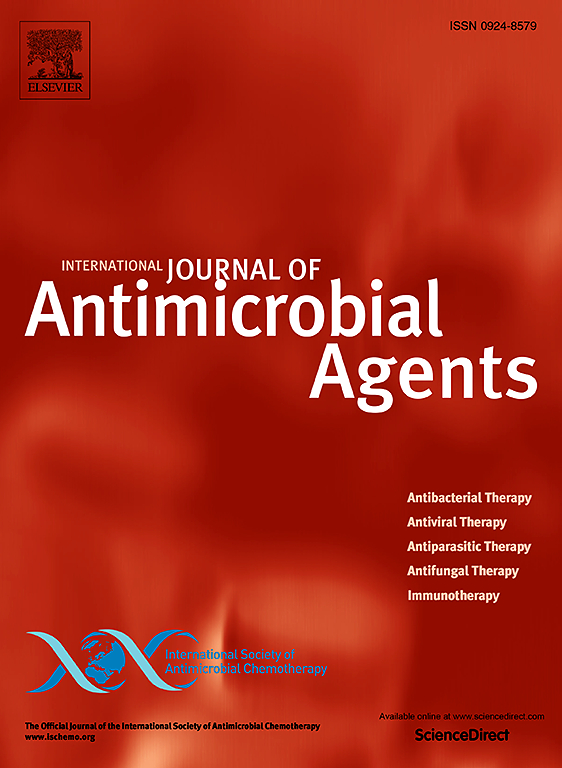肠杆菌头孢吡肟-他尼巴坦药敏/耐药快速检测。
IF 4.6
2区 医学
Q1 INFECTIOUS DISEASES
International Journal of Antimicrobial Agents
Pub Date : 2025-06-20
DOI:10.1016/j.ijantimicag.2025.107557
引用次数: 0
摘要
产生金属β-内酰胺酶(MBL)的肠杆菌分布广泛,对所有β-内酰胺类,包括碳青霉烯类具有耐药性。最近,已经开发了头孢吡肟-他尼波巴坦组合,旨在构成由产生mbl的细菌引起的感染的治疗选择。本研究的目的是开发一种快速诊断试验,即快速头孢吡肟- taniborbactam NP,用于早期鉴定肠杆菌中头孢吡肟- taniborbactam的药敏/耐药。快速头孢吡肟-taniborbactam NP测试是基于检测由细菌生长引起的葡萄糖代谢,并通过在头孢吡肟-taniborbactam存在下红酚的颜色变化(从红色到黄色)来检测。选取103株肠杆菌,包括94株碳青霉烯酶产生菌,对头孢吡肟- taniborbactam NP试验进行性能评价。在没有可用断点的情况下,采用两个临时断点进行解释,一个对应于CLSI当前头孢吡肟耐药断点(R≥16mg /L),另一个遵循当前文献中关于该组合的研究(R≥32mg /L)。当耐药临界点≥16 mg/L时,该试验的敏感性和特异性分别为95%和98%。当考虑≥32 mg/L的耐药临界点时,其敏感性为100%,特异性为91%。所有结果均在35°C±2°C的3小时潜伏期内获得,与目前的抗菌药物敏感性测试方法相比,时间显着减少。本研究结果表明,快速头孢吡肟- taniborbactam NP试验是一种高度准确和高效的细菌耐药检测技术。本文章由计算机程序翻译,如有差异,请以英文原文为准。
Rapid detection of cefepime-taniborbactam susceptibility/resistance in Enterobacterales
Objective
Metallo-β-lactamase–producing Enterobacterales is widely distributed and confers resistance to all β-lactams, including carbapenems. Recently, a cefepime-taniborbactam combination has been developed that aims to provide a treatment option for infections caused by metallo-β-lactamase–producing bacteria. The objective of this study was to develop a rapid diagnostic test, namely the Rapid Cefepime-Taniborbactam NP test, for the early identification of cefepime-taniborbactam susceptibility or resistance in Enterobacterales.
Methods
The Rapid Cefepime-Taniborbactam NP test is based on the detection of glucose metabolism resulting from bacterial growth, detectable by a change in colour of a red phenol (from red to yellow) in the presence of cefepime-taniborbactam. A total of 103 Enterobacterales isolates, including 94 carbapenemase producers, were selected for evaluation of the performance of the Rapid Cefepime-Taniborbactam NP test. In the absence of available breakpoints, two provisional breakpoints were taken for the interpretation—one corresponding to the current Clinical and Laboratory Standards Institute cefepime resistance breakpoint (R ≥ 16 mg/L) and one following current literature on this combination (R ≥ 32 mg/L).
Results
The test demonstrated a sensitivity and specificity of 95% and 98%, respectively, following a resistance breakpoint of ≥16 mg/L. When considering a resistance breakpoint of ≥32 mg/L, the sensitivity and specificity were found to be 100% and 91%, respectively. All results were obtained within a 3 h incubation period at 35°C ± 2°C, representing a significant reduction in time compared with current antimicrobial susceptibility testing methods.
Conclusions
The results of this study demonstrate that the Rapid Cefepime-Taniborbactam NP test is a highly accurate and time-efficient technique for the detection of bacterial resistance.
求助全文
通过发布文献求助,成功后即可免费获取论文全文。
去求助
来源期刊
CiteScore
21.60
自引率
0.90%
发文量
176
审稿时长
36 days
期刊介绍:
The International Journal of Antimicrobial Agents is a peer-reviewed publication offering comprehensive and current reference information on the physical, pharmacological, in vitro, and clinical properties of individual antimicrobial agents, covering antiviral, antiparasitic, antibacterial, and antifungal agents. The journal not only communicates new trends and developments through authoritative review articles but also addresses the critical issue of antimicrobial resistance, both in hospital and community settings. Published content includes solicited reviews by leading experts and high-quality original research papers in the specified fields.

 求助内容:
求助内容: 应助结果提醒方式:
应助结果提醒方式:


